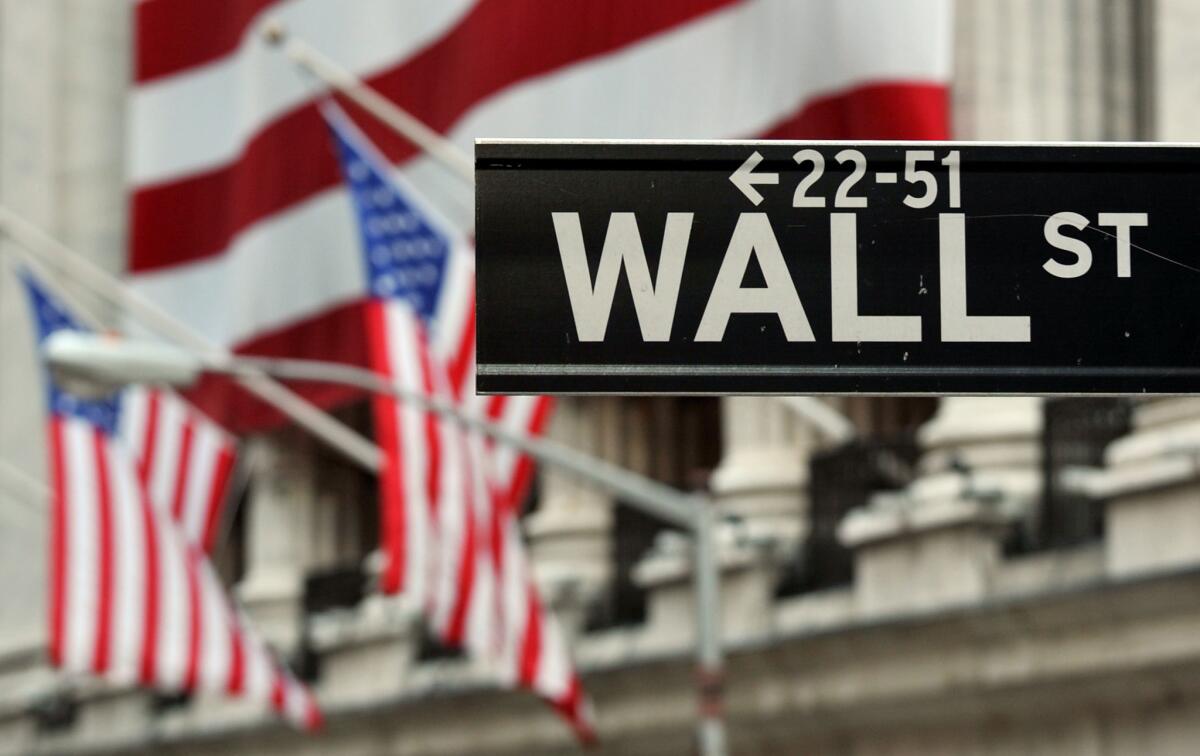Stocks rise on hope that the worst of the economic plunge is over

- Share via
Even with the economy still in miserable shape, some investors are finding reasons to hope the worst of the plunge may have passed, and Wall Street rallied Thursday to its biggest gain in a week.
The Standard & Poor’s 500 index climbed 1.2%, notching its third gain in four days, as it followed similar increases in European markets. Other areas of the U.S. market were still showing much more pessimism, though, including bonds.
The day’s headliner economic report showed that an additional 3.2 million U.S. workers applied for jobless benefits last week, bringing the total to 33.5 million over the last seven weeks. It’s a shocking number, but it’s also the fifth consecutive week that the number of new filings has declined since peaking in late March.
Several companies also cited signs that the worst may have passed in some parts of their businesses, though more weakness is still definitely on the horizon.
That was enough to bolster hopes that have coursed through the stock market recently, with investors looking ahead to a future that’s not as bad as the horrific present.
The S&P 500 rose 32.77 points to close at 2,881.19. The Dow Jones industrial average rose 211.25 points, or 0.9%, to 23,875.89. The Nasdaq climbed 125.27 points, or 1.4%, to 8,979.66, pulling itself out of the red for the year.
“Investors are saying, ‘Look, I know things are bad. Tell me something I don’t know,’ ” said Sam Stovall, chief investment strategist at CFRA. “If I know things are going to be horrendous, the only way you can surprise me is to the upside.”
Everyone agrees the world is sliding into a severe recession after economies worldwide shut down in hopes of slowing the spread of the coronavirus. But some countries and U.S. states are laying out plans to relax restrictions, which has some investors focusing on the possible resumption of growth later this year.
Investors on Thursday found solace in numbers from other countries further ahead in reopening their economies, which haven’t shown a renewed surge in COVID-19 cases, said Quincy Krosby, chief market strategist at Prudential Financial.
“When you watch other countries opening and doing it successfully without an uptick in cases, it portends well for the U.S.,” she said.
Also helping to boost the market, she said, was a federal regulatory approval for the second phase of testing on a potential COVID-19 vaccine from Moderna.
The S&P 500 has more than halved the 33% plunge it posted in February and March, beginning its rally after the Federal Reserve and Capitol Hill pledged massive amounts of aid for the economy. Many analysts have been skeptical of the rally, saying it’s overdone given how much uncertainty still exists about how long the recession will last.
Lyft jumped 21.7% after it said late Wednesday that ride levels appear to have steadied after hitting a bottom in the second week of April. Over each of the three following weeks, the number of rides has grown from the previous week, though they’re still down more than 70% from the same time last year.
Stocks whose fortunes are most closely tied to the strength of the economy helped lead the market. Energy producers in the S&P 500 rose 2.5%, the biggest gain among the 11 sectors that make up the index. Financial stocks were close behind. Those sectors have been among the hardest-hit this year on worries that the recession is erasing demand for oil and could lead to a wave of loan defaults for banks.
The bond market offered a much more cautious take. The yield on the 10-year Treasury fell to 0.63% from 0.71%. Yields tend to fall as investors downgrade their expectations for economic growth and inflation.
The 10-year yield had climbed strongly the day before after the U.S. government gave an update on how it’s borrowing to help pay for the trillions of dollars it’s pumping into the economy to fight the effects of the pandemic.
The yield on the two-year Treasury fell to a record low Thursday, according to Tradeweb.
In Europe, gains were widespread for stocks. France’s CAC 40 rose 1.5%. Germany’s DAX and the FTSE 100 in London each gained 1.4%.
Encouraging data showed a 3.5% rise in exports for China in April, driven by electronics shipments and textiles, which included a surge in exports of masks. Forecasters warned the strength is unlikely to last, though, as the coronavirus pandemic depresses global consumer demand.
Most Asian markets slipped Thursday. South Korea’s Kospi was close to flat. Hong Kong’s Hang Seng fell 0.6%. Stocks in Shanghai slipped 0.2%.
Benchmark U.S. crude oil fell 44 cents, or 1.8%, to $23.55 a barrel. Brent crude oil, the international standard, fell 26 cents, or 0.9%, to $29.46 a barrel.
More to Read
Inside the business of entertainment
The Wide Shot brings you news, analysis and insights on everything from streaming wars to production — and what it all means for the future.
You may occasionally receive promotional content from the Los Angeles Times.










